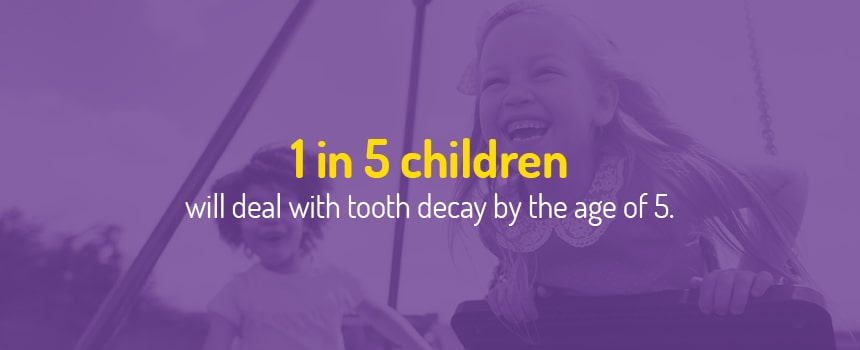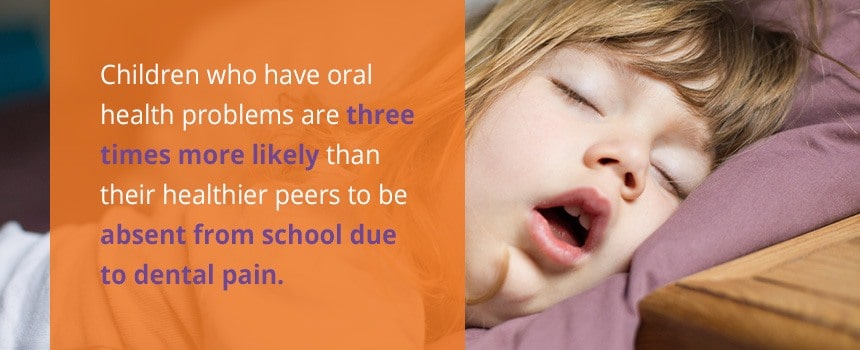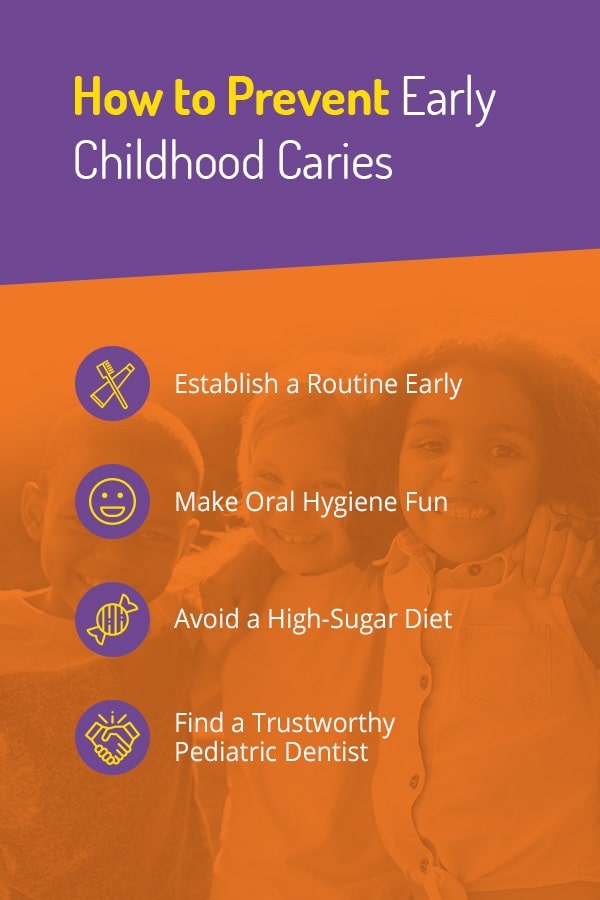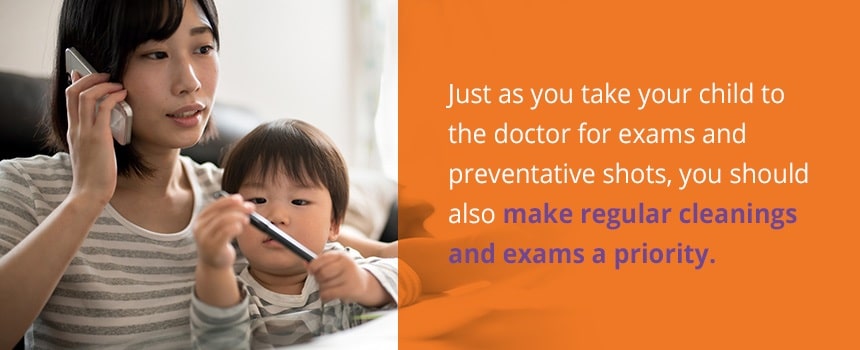State of Little Teeth Report 2019: A Look At The Epidemic of Tooth Decay in Children
Use the links below to jump to sections in this post on the 2019 State of Little Teeth report findings.
- Key Findings
- Primary Causes of Tooth Decay
- How to Prevent Early Childhood Caries
- Children Are Waiting Too Long for Their First Dental Visit
- The Role of Parents and Dental Providers
What’s going on in your child’s mouth?
If you’re like most parents, you can rattle off your child’s shot record, identify the source of every scrape or bruise on their legs, and remember the dosage for at least three different over-the-counter medications.
But when it comes to dental health, many parents aren’t quite as diligent.
We don’t blame you.
Have you ever tried to convince a stubborn 2-year-old to brush their teeth? Have you ever grown tired of reminding your elementary school-aged child that gum isn’t a substitute for brushing before school?
Setting the bar high for healthy teeth is more important than ever, according to the 2019 State of Little Teeth Report released by the American Academy of Pediatric Dentistry (AAPD).
The report, which examines the epidemic of tooth decay among children, found that tooth decay is the most common chronic infectious disease impacting U.S. children, and the rate of tooth decay being reported in baby teeth has risen by 17% in the last 20 years.
What does that mean?
It means that it’s more important than ever to understand how tooth decay can impact children and how parents can teach their children to care for their oral health.
Key Findings

Tooth decay in children — also called early childhood caries (ECC) — is what happens when the enamel on a child’s teeth is compromised by bacteria that destroy the tooth enamel. Where do the bacteria come from?
Your mouth produces bacteria naturally, but when you eat or drink a lot of sugary foods or beverages, bacteria multiply faster, producing acid that erodes teeth. Tooth decay is possible at any age, but it has become an increasing problem among children, with the numbers pointing to an epidemic of caries in kids.
In response to this problem, the AAPD’s recent report aims to identify the source of the problem among children, as well as offer some recommendations for parents and pediatric dentists to assist in improving the state of children’s oral health.
The report’s key stats on kids’ teeth include:
-
- Too Many Kids Experience Tooth Decay: Many parents don’t realize the seriousness of tooth decay. They reason that their children’s baby teeth aren’t as valuable as permanent teeth since they’ll lose them, or they don’t like arguing with children who don’t want to brush daily. The truth is that one in five children will deal with tooth decay by the age of 5. Even after the age of 5, it continues to be a serious problem that, if left untreated, can impact a child’s sleep, school performance, speech development and self-esteem.
-
- Children in Low-Income Families Are High Risk: While all children are at risk for tooth decay, the report’s authors revealed that children in low-income families are much more likely to struggle with tooth decay. In fact, children living in poverty are twice as likely to suffer from the effects of tooth decay, and they are less likely to receive dental treatment for the problem. Communities continue to increase dental access for low-income populations, including an expansion of dental benefits for publicly insured children, to remove the financial obstacles that prevent patients from visiting the dentist.
-
- Ignoring Tooth Decay Will Cost You: If you ignore the problem, treatment for tooth decay can be more than just one or two fillings. On average, the treatment for severe tooth decay costs $10,000 — more if anesthesia and a hospital visit are required for surgical treatment. The longer treatment is put off, the more expensive and invasive treatment becomes. If tooth decay is prevented — or detected in the early stages — your dentist can help you save money and keep your child more comfortable.
-
- Children Need to Start Regular Dental Visits Sooner: Many parents don’t realize that their child’s first dental visit should take place within six months of their first tooth or by the time they turn one — whichever comes first. An AAPD survey found that 74% of parents don’t take their child to the dentist before their first birthday. When regular dental visits are incorporated into a child’s development from the beginning, they grow up understanding the importance of dental hygiene. Early visits also help to mitigate apprehension over dental visits for two reasons — first, because the child will be more familiar with their dentist, and second, because potential problems will be detected before they require painful and scary — for children — solutions.
- Pediatric Dentists Are Underutilized But More Important Than Ever: In 2016, there were approximately nine pediatric dentists for every 100,000 children. If the current graduation rates for dental schools continue, that number should rise to 14 for every 100,000 by the year 2030. Why does this matter? Pediatric dentists are highly-trained dental professionals who’ve attended several years of specialized schooling beyond dental school. A pediatric dentist is trained to help your child protect their teeth and gums, and they have specialized knowledge that can help when problems arise. Pediatric dentist recommendations can be an important resource for all families!
Primary Causes of Tooth Decay

Tooth decay is caused when bacteria in the mouth multiply and produce an increased amount of acid that coats the teeth. Over time, the acid wears away the enamel, and the tooth begins to decay. In the beginning, a child may experience some pain or discomfort while eating. Their teeth may become sensitive to extreme temperatures, and there may be some noticeable staining. Tooth decay can cause cavities that a dentist can usually fill.
Many parents believe that cavities are no big deal and, in some cases, they may be an isolated event. However, often a cavity is the outward sign of a bigger problem. If the cause of decay isn’t addressed, a child may experience problems sleeping and miss school as a result of their pain or discomfort.
In fact, the AAPD’s report found that children who have oral health problems are three times more likely than their healthier peers to be absent from school due to dental pain.
Tooth decay is a big deal. But to help your child prevent it from occurring, you have to understand how it occurs. Typically childhood tooth decay results from:
-
- High Sugar Consumption: Foods and drinks that are high in starches and sugars are the primary culprits of tooth decay — soda, juice, cakes and candy are all to blame. Consuming these occasionally isn’t going to doom a child to a life of tooth decay, but frequent consumption increases a child’s risk of decay over time. It’s easy to place the blame on foods typically labeled as “junk food,” but many parents don’t realize that beverages like milk and juice, as well as “healthy” snacks like raisins and other dried fruit, can also cause problems. Excessive consumption of these healthier options can also increase the number of bacteria in your child’s mouth since they still contain a lot of sugar and often remain on a child’s teeth for extended periods because they are consumed between meals. The problem with these foods and beverages comes when they linger on a child’s teeth for several hours. Children should brush after meals (or at least drink water), and they should never be allowed to fall asleep with a cup of milk or juice for this reason.
- Poor Dental Hygiene: Children aren’t born knowing how to brush and floss. If they don’t have a consistent home oral hygiene routine, then they aren’t doing their part to combat the buildup of bacteria in their mouth. This can be difficult for parents of young children because they often fight their parents on brushing. If you’re struggling to incorporate a good oral hygiene routine into your day, check out these tips for success!
How to Prevent Early Childhood Caries
It’s easy for dentists to offer recommendations. After all, they aren’t the ones having daily arguments with your preschooler about brushing. They aren’t the ones who have to watch your child downing cupcakes at their friend’s birthday party. But, dentists also know that the struggle will be worth it in the long run, and there are plenty of practical ways you can apply their advice on a day-to-day basis. After all, many pediatric dentists are also parents and have children themselves!
-
- Establish a Routine Early
You can begin cleaning a baby’s gums long before their first tooth emerges. Simply take a clean, damp cloth and run it along their gums — both bottom and top. Once your child’s teeth begin to emerge, immediately start brushing morning and evening. It may seem silly to brush one or two teeth, but remember — you’re establishing a routine. The more you do it now, the less you’ll argue over it later.
- Establish a Routine Early
-
- Make Oral Hygiene Fun
Just because it’s serious business doesn’t mean oral hygiene can’t be fun! Pick your child’s favorite song and sing it while they brush, telling them they have to brush until the song is finished. Pick out a video online that can capture their attention or read a book. If they’re still giving you trouble, offer a non-edible incentive for tooth brushing, such as a trip to the park.
- Make Oral Hygiene Fun
-
- Avoid a High-Sugar Diet
Kids will eat candy and drink juice. There’s really no way to avoid that. But help them establish healthy habits by making those special treats instead of every-day habits. Their day-to-day diet and snacks should be low in sugar to protect their teeth.
- Avoid a High-Sugar Diet
- Find a Trustworthy Pediatric Dentist
Children should have their first dental visit within six months of their first tooth arriving or by the time they turn 1 — whichever comes first. Yes, they don’t have many teeth, but at this age, you’re helping them acclimate to being at the dentist. If they’re used to it, it won’t be as scary when they’re older, and they’ll be more likely to stay calm during regular cleanings and exams.
This is where a good pediatric dentist can be helpful. Besides being well-versed in pediatric dental issues, a pediatric dentist is trained to work with young children and can assist parents in the process of acclimating children to the dentist. They are also some of the kindest, most patient people you’ll meet!

Children Are Waiting Too Long for Their First Dental Visit
Unfortunately, many children are waiting too long for their first dental visit. This doesn’t automatically mean they’ll experience tooth decay, but it puts them at higher risk for it. Why? The purpose of regular dental visits is largely to prevent problems from forming. If your child is seeing a dentist every six months from the time they’re a 1-year-old, a dentist has a better chance of identifying red flags and potential problems before they spiral out of control. This isn’t a guarantee that problems will never arise, but it goes a long way in preventing them and treating them early.
The Role of Parents and Providers: The Importance of a Secure Dental Home

Preventing tooth decay is a team effort between parents and dental providers. Both are essential roles that complement each other and help to protect a child from the effects of tooth decay. This is increasingly referred to as the “Dental Home.”
The AAPD defines a “Dental Home” as an ongoing patient-dentist relationship that encompasses all aspects of oral health. In other words, it’s a two-way relationship in which both parties are committed to your child’s overall health and wellbeing.
As a parent, your job is to stress the importance of good oral hygiene at home. You can help your child establish habits and practices that they will carry with them throughout their entire life.
Yes, it’s challenging. And yes, there are days you’ll want to throw in the toothbrush, but we urge you to stay the course! Consider oral hygiene another part of your child’s routine, just as they brush their hair, change their clothes and take a bath.
It’s also your job to schedule regular dental exams and attend them with your child. Just as you take your child to the doctor for exams and preventative shots, you should also make regular cleanings and exams a priority.
Pediatric dental providers can work closely with parents to provide resources and support as they teach their children about oral hygiene.
Your child’s dentist is there for more than just periodic cleanings! They are there to offer information about oral hygiene, support as you teach your child and provide care if a problem arises. They can also offer suggestions for ways to help your child improve their brushing or incorporate other practices into their routine. They see hundreds of children every month — let them share their wisdom and experiences with you!
Fox Kids Dentistry & Orthodontics
At Fox Kids, we’re committed to helping you establish a secure dental home for your child from the beginning. We combine our dental and orthodontic practice so that you don’t have to go between two different practices and locations as your child grows. We find that this combination allows us to provide high-quality continuity of care, as well as be respectful of your busy schedule.
As a fixture of the Portland area, we welcome new patients — especially if your child is just beginning their oral health journey. Our experienced staff of dentists, orthodontists and hygienists are experienced with helping to put your child at ease and work alongside you to teach them how to care for their teeth for years to come.
Contact us today to set up an appointment!

